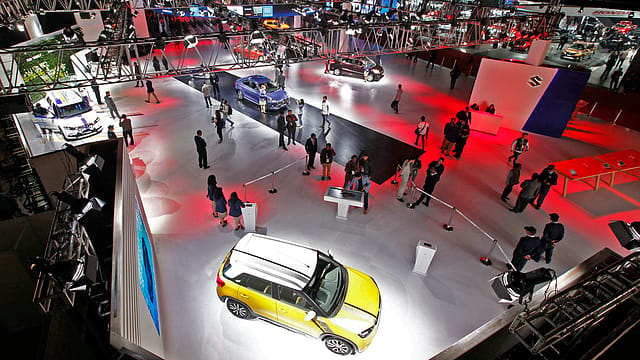M&M, Maruti, Tata look to outpace 1-2% PV industry growth in FY26
ADVERTISEMENT

India’s passenger vehicle volumes are expected to grow 1-2% in the financial year 2025-26, according to industry estimates. Maruti Suzuki is looking to outpace the industry growth with the launch of two new SUVs, including its maiden electric vehicle, the e-Vitara. Mahindra & Mahindra (M&M) is eyeing mid- to high-teens growth aided by its SUV-dominated product portfolio. Tata Motors , which saw a 3% decline in domestic sales in FY25, expects to outpace the industry growth in FY26. However, Hyundai Motor India expects to grow broadly in line with Industry estimates of low-single digit in FY26. Domestic wholesales of the South Korean carmaker declined 2.6% year-on-year to 5.98 lakh units in FY25 from 6.14 lakh units in FY24.
In the month of April 2025, Maruti Suzuki remained India’s largest carmaker by volumes while M&M emerged as India's second-largest carmaker. M&M’s market share rose to 13.83% last month from 11.23% in April 2024. Meanwhile, Hyundai Motor India's market share slipped to 12.47% in April 2025, making it the fourth-largest carmaker after Tata Motors.
While rural demand continues to be strong, automakers have noted stress in the urban markets. “We have not seen any slowdown in urban even though the urban economy at this moment is much tighter. There are many enabling factors in the rural economy,” Rajesh Jejurikar, Executive Director and CEO, Auto & Farm Sector, M&M, said in an earnings call after the company announced its fourth quarter results.
January 2026
Netflix, which has been in India for a decade, has successfully struck a balance between high-class premium content and pricing that attracts a range of customers. Find out how the U.S. streaming giant evolved in India, plus an exclusive interview with CEO Ted Sarandos. Also read about the Best Investments for 2026, and how rising growth and easing inflation will come in handy for finance minister Nirmala Sitharaman as she prepares Budget 2026.
In FY25, India's automobile industry witnessed a strong performance in rural areas while urban markets remained under stress, according to the Federation of Automobile Dealers Associations of India (FADA). Sales of two-wheelers in rural markets grew by 8.39%, comfortably outpacing the urban growth of 6.77%, while passenger vehicles posted 7.93% growth in rural sales, compared to 3.07% in cities, the dealers’ association said.
Passenger vehicle sales in India grew by a modest 2% in FY25, but set a new record with over 43 lakh units sold. This growth was fuelled by the rising popularity of SUVs—which accounted for 55% of total sales. According to Crisil, India’s passenger vehicle (PV) industry is set to scale a fresh high this fiscal with domestic and export volume cumulatively crossing 50 lakh units even as the annual growth rate slows to 2%. The domestic market accounted for around 85% of total volume last fiscal, with exports accounting for the rest.
Utility vehicles will drive volume growth this fiscal, aided by new launches, easing interest rates, rising compressed natural gas (CNG) adoption and rural tailwinds, said Crisil. However, gains will be capped by weak adoption of electric vehicles (EV) and sluggish sales of entry-level cars and sedans. As volume growth slows, original equipment manufacturers (OEMs) will rely on premiumisation and better product mix to protect margins, the rating agency said.
“PV growth will moderate to 2-4% this fiscal, but UVs will continue to cruise with ~10% growth, supported by new launches. With UVs contributing 68-70% of volumes and bulk of upcoming models, the shift toward premiumisation is structural. Rural recovery, expected from likely above-normal monsoon and reduction in interest rates, should improve demand for entry-level cars,” said Anuj Sethi, Senior Director, Crisil Ratings.
Growth in electric vehicles (EVs) has slowed after doubling last year, but on a low base. Despite a flurry of launches and declining battery costs, penetration is seen moderate at 3-3.5%, weighed down by high prices, modest charging infrastructure and range anxiety, restricting the market to urban users as a second car option, said Crisil.
